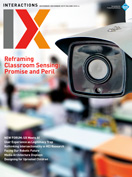Authors:
Simone Barbosa, Gilbert Cockton
As practitioners and researchers, we are always dealing with multiple and evolving perspectives, tensions, and tradeoffs. In this issue's cover story, Amy Ogan discusses the good and the bad of classroom sensing for teacher development. Paul Dourish urges us to acknowledge and escape the legitimacy trap into which UX may have fallen, and to bring ethics and values front and center. Focusing on ourselves as whole humans with bodies and minds, Kristina Höok in Abracadabra wishes women in design research could focus entirely on research, not their gender, encouraging us to embrace our subjectivities and somas when designing from a first-person perspective. Ron Wakkary explores design history and contemporary theory, and shares a few books on assemblage, agentic capabilities, and Italian design.
Focusing on inclusion and diversity, Julie Carpenter shows how the Q project was conceived to encourage dialogue around gender, identity, and technology. Yolanda A. Rankin and Jakita O. Thomas prompt us to acknowledge and understand the origins of intersectionality and the risks of misappropriation. Alissa Antle and colleagues discuss issues, challenges, and opportunities involved in designing for uprooted children. Designing to include vulnerable populations is not straightforward, but Ashley Marie Walker and colleagues illuminate a path forward.
The idea of engaging communities permeates this issue.
The idea of engaging communities permeates this issue. Laura Cortés-Rico and Tania Pérez-Bustos reflect on ways of doing fieldwork in two sociotechnical research projects for cultural craft heritage. Andre Bueno and Junia Anacleto describe E-goras, showing us how we can move beyond smart cities to inclusive, online civic smart communities. And in Day in the Lab, Roberta de Andrade and Ingrid Monteiro describe how, through their INOVE lab at the Federal University of Ceará in Quixadá, Brazil, they have built an ecosystem of technological innovation, fostering multidisciplinary research and collaboration with industry in a low-resource community.
This issue also brings together the material and the virtual. Kim Halskov and Aron Fischel discuss what happens when buildings become displays, exploring the unique properties of media-architecture displays as a design space. And Victoria McArthur explores augmented reality as a storytelling medium, looking into HCI to help journalists understand readers as users.
Rethinking the role of technology is the theme of this issue's How Was It Made and Demo Hour sections: hiding phones inside prototypes to explore our stance as museum visitors and the impact of technology on our family lives, designing prototypes to explore our role as caregivers and our flexible office workspaces, and changing the way we design and engineer shoes. Inspiration can come from unexpected places, such as a broken guitar string that makes us think about complex systems, or from the Finsterworlds movie, reminding us to empower humans through tech, rather than trapping them in cool dark tech paths that lead nowhere. Matt Jones sheds some light on how to avoid a robotic future and, instead, realize the vision of empowering and amplifying humans. Dwelling in the intersection between humans and technology, Uday Gajendar digs into some overlaps between humanization and automation.
HCI has always involved dealing with tensions. Inaugurating the UX Meets AI forum, Henriette Cramer and Juho Kim call upon us to share our experiences in tackling the tensions that arise when integrating AI and UX design. We welcome them to our team and join them in inviting your contributions to this vitally important discussion.
Simone Barbosa and Gilbert Cockton [email protected]
Copyright held by authors
The Digital Library is published by the Association for Computing Machinery. Copyright © 2019 ACM, Inc.







Post Comment
No Comments Found